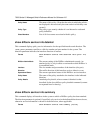
7000 Series L3 Managed Switch Reference Manual for Software v2.0
9-36 CLI Commands: Differentiated Services
Interface Sent Octets/Packets A cumulative count of the octets/packets forwarded by this ser-
vice interface in the specified direction after the defined DiffServ
treatment was applied. In this case, forwarding means the traffic
stream was passed to the next functional element in the data path,
such as the switching or routing function or an outbound link
transmission element.
The following information is repeated for each class instance within this policy:
Class Name The name of this class instance.
In Offered Octets/Packets A count of the octets/packets offered to this class instance before
the defined DiffServ treatment is applied. Only displayed for the
'in' direction.
In Discarded Octets/Packets A count of the octets/packets discarded for this class instance for
any reason due to DiffServ treatment of the traffic class. Only dis-
played for the 'in' direction.
Tail Dropped Octets/Packets A count of the octets/packets discarded due to tail dropping from
a transmission queue, typically due to the effects of traffic shap-
ing. These counts may not be supported on all platforms. Only
displayed for the 'out' direction.
Random Dropped
Octets/Packets
A count of the octets/packets discarded due to WRED active
queue depth management, typically due to the effects of traffic
shaping. These counts are only applicable for a class instance
whose policy attributes includes random dropping, and may not
be supported on all platforms. Only displayed for the 'out' direc-
tion.
Shape Delayed
Octets/Packets
A count of the octets/packets that were delayed due to traffic
shaping. These counts are only applicable for a class instance
whose policy attributes includes shaping, and may not be sup-
ported on all platforms. Only displayed for the 'out' direction.
Sent Octets/Packets A count of the octets/packets forwarded for this class instance
after the defined DiffServ treatment was applied. In this case, for-
warding means the traffic stream was passed to the next func-
tional element in the data path, such as the switching or routing
function or an outbound link transmission element. Only dis-
played for the 'out' direction.


















